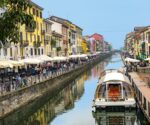The beautiful country that looks tiny on Europe’s map but is the 12th largest in the world | Europe | Travel
At first glance, Denmark, a small Scandinavian country nestled on the European coast, seems fairly small in size. But dig a little deeper and you’ll find that the Kingdom of Denmark is much more expansive than it initially appears.
The Kingdom of Denmark is made up of several constituent territories bound together by its Constitutional Act, which applies across all its lands. The nation includes metropolitan Denmark, often referred to as ‘Denmark proper’, and two autonomous yet not sovereign regions. These two territories are the Faroe Islands in the North Atlantic and Greenland in North America. The bond between these three parts of the kingdom is known as rigsfællesskabet (the unity of the realm). The Kingdom of Denmark isn’t a federation but rather a concept that includes the three autonomous legal systems of the country. Both the Faroe Islands and Greenland are united under its monarch.
The Kingdom is a unitary sovereign state with territorial claims in the Arctic, including several sites near the North Pole.
While the Kingdom of Denmark constitutionally encompasses the realm or the country, the Faroe Islands and Greenland enjoy a high degree of autonomy in managing their affairs. These two territories have been under Danish rule since 1397 (de facto) with the ratification of the Kalmar Union.
They’ve been part of the Danish Realm since 1814 (de jure) by law and now possess a significant degree of self-government.
The territories have taken on legislative and administrative duties in various areas due to their unique historical and cultural identities, as well as their distinct locations. The Constitution of the Kingdom of Denmark refers to this arrangement as Damarks Rige, or the Danish Realm.
The previously mentioned term rigsfællesskabet describes the constitutional relationship between Denmark, the Faroe Islands, and Greenland.
There’s a significant population gap among the three locations, with Denmark Proper housing 5.8 million people, while Greenland has 56,000 residents and the Faroe Islands have 52,000. There are 10 cities in mainland Denmark that have over 50,000 inhabitants, highlighting the disparity in population sizes.
Denmark is inhabited by the Danes, the Faroe Islands by the Faroese, and Greenland by the Greenlandic Inuit. As of 2018, Danes constitute 7.6% of the population in both the Faroe Islands and Greenland. In 2020, there were about 11,000 Faeroese-born and 17,000 Greenlandic-born people documented living in Denmark.
What Greenland lacks in population, it compensates with area size. The country is by far the largest in the kingdom and makes up 98% of the realm, according to the World Factbook, it is the 12th-largest nation in the world. Denmark which is located in Northern Europe, has an area of about 43,000 km2, and is no. 133 on that list.
The differences don’t stop there, Denmark has a reputation for being relatively flat and arable while the Faroe Islands in the Northern Atlantic are rugged and famed for their large cliffs along the coastline. Greenland is nown for being covered in ice with about 79% of its surface coated in the substance and is known as the most sparsely populated territory in the world — according to the World Bank.








